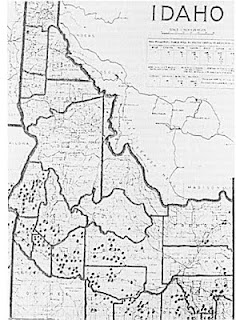 |
| Dr. Maxey. H. T. French photo. |
In 1891, Edward graduated from the College of Physicians and Surgeons in Chicago, and followed up with post-graduate work.
After his studies, he returned to Caldwell to join his father’s practice. For some reason, he then tried to open an office in Walla Walla, Washington, but gave that up after just a couple of months. He then returned to Caldwell and opened his own practice. While there, he acted as a Resident Surgeon for the Oregon Short Line Railroad. He also served as Coroner for the city of Caldwell. When the legislature split Canyon County off from Ada County in 1892, Maxey was appointed as the first county Coroner. He then ran for and was elected to the position.
Dr. Maxey moved to Boise in 1902, but was apparently associated with the Canyon County Coroner’s position for several years after that. He wrote and signed the post mortem report for Albert K. Steunenberg [blog, Sept 11] after Albert's death in 1907.
Wanting to keep up with the latest techniques, Maxey took a number of “sabbaticals” from his practice for additional study. Thus, in 1904, he spent six months taking medical courses in New York and then at Johns Hopkins University. (Earlier, he spent six weeks in Chicago for the same purpose.) Then, in 1908, he went overseas to Vienna, Berlin, and London to further his medical education. He returned to Boise early in 1910 and opened a practice as an eye, ear, nose and throat specialist.
Dr. Maxey was a Charter Member of the Idaho State Medical Society, serving several terms as its Secretary and a term as President in 1901. He was also a member of the American Medical Association, several organizations related to his specialty, and acted as Surgeon General for the Idaho National Guard. During World War I, he served as a major in the U. S. Army. Then in his fifties, Dr. Maxey supervised a base hospital in Wyoming.
Along with his general and then specialist practice, Dr. Maxey took an active interest in medical research. He was one of several physicians in the Boise Valley who began the systematic study of Rocky Mountain Spotted Fever [blog, March 30]. Collectively, these Idaho doctors gave the first clinical description of the disease, and provided some idea of how it spreads – the “vectors.”
 |
| Maxey’s Spotted Fever Map. Reproduced in Hammersten. |
In the summer of 1899, Maxey presented a paper on the disease at a medical conference in Oregon. A few months later, the manuscript of that presentation became the first paper about the disease to be published in a medical journal.
Nine years later, he presented a paper at a Rocky Mountain Spotted Fever Symposium sponsored by the Idaho Medical Association. During the intervening years, research had suggested ticks as a primary vector for the infection. Maxey collected a considerable body of data from all across Idaho. He found that around 92 percent of the reported cases affected people who lived “an outdoor life.” In 1913, Maxie wrote a chapter on the disease for a well-known medical reference book.
Dr. Maxey moved his practice to Aberdeen, Washington, on Grays Harbor, in 1925. He had a heart attack and died in his office there at the end of August 1934.
| References: [French], [Illust-State] |
| “[Dr. E. E. Maxey News],” Idaho Statesman, Boise; Tribune, Caldwell, Idaho (July 1892 – September 1934). |
| James F. Hammarsten, “The Contributions of Idaho Physicians to Knowledge of Rocky Mountain Spotted Fever,” Transactions of the American Clinical and Climatological Association, Vol. 94 (1983). |
| Ed. E. Maxey and (unreadable), Post Mortem Findings at Examination of A. K. Steunenberg, hand-written report, Caldwell, Idaho (March 18, 1907). |
| Marshall W. Wood, “Spotted fever as reported from Idaho,” Report of the Surgeon General, U. S. Army, 1896, Government Printing Office (1896). |

No comments:
Post a Comment